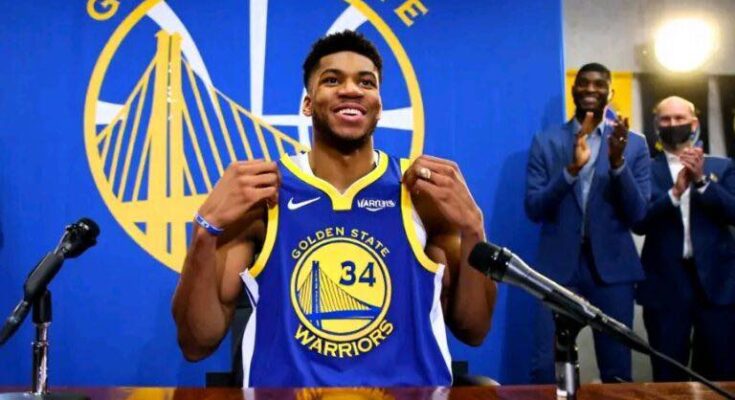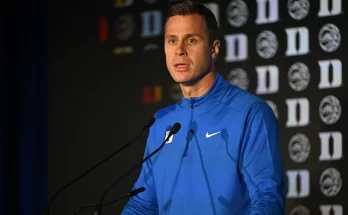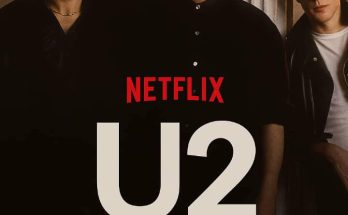The Golden State Warriors Take a Serious Hit While Chasing Antetokounmpo
The Golden State Warriors have long been one of the NBA’s most iconic and successful franchises of the modern era. Known for their revolutionary style of play, emphasizing pace, space, and unparalleled shooting prowess, the Warriors have set the gold standard in basketball excellence over the past decade. However, as the landscape of the NBA continues to evolve with the emergence of new superstars and shifting power dynamics, Golden State finds itself at a crossroads — notably in its ambitious pursuit of Giannis Antetokounmpo, the Milwaukee Bucks’ unstoppable force and one of the league’s most coveted talents.
This pursuit, while tantalizing in theory, has come at a serious cost to the Warriors, both on and off the court. From roster upheavals to financial strain and internal chemistry concerns, the quest for Giannis has introduced challenges that threaten to undermine the Warriors’ carefully built dynasty. This article will examine the depth of the Warriors’ challenges, analyze the factors that have contributed to their setbacks, and explore what this means for their future in the ultra-competitive NBA.
Before diving into the setbacks, it’s important to understand why the Warriors would chase a player like Giannis Antetokounmpo in the first place.
Giannis is a once-in-a-generation talent. Standing 6-foot-11 with an extraordinary combination of speed, strength, and skill, he is a relentless force on both ends of the floor. A two-time NBA MVP, Defensive Player of the Year, and NBA Champion, Giannis embodies the kind of transformational player who can elevate any franchise into title contention.
Golden State’s core—Stephen Curry, Klay Thompson, and Draymond Green—has been exceptional, but the league is shifting. The Bucks, Brooklyn Nets, Milwaukee, Boston Celtics, and even Los Angeles Lakers are all contending with superstar-laden rosters. Adding Giannis would theoretically give the Warriors a dominant “big man” presence to complement their lethal shooting and playmaking. Such a move would be aimed at extending their championship window and keeping pace with the superteam arms race.
But chasing a superstar of Giannis’ caliber in today’s NBA is never easy, especially under the Warriors’ salary cap constraints and their commitment to maintaining core players who have earned their spot through years of success. The process has involved tough decisions, sacrifices, and unfortunately, unexpected setbacks.
The most immediate and visible consequence of the Warriors’ pursuit of Giannis has been significant roster disruption. To create the financial space and trade assets necessary to acquire Giannis, Golden State has had to part ways with valuable contributors.
In their attempt to woo Milwaukee, the Warriors traded away some of their promising young talent and role players who provided depth and defensive toughness. For instance, the departure of Andrew Wiggins—who had become an important two-way player in Golden State’s system—left a glaring hole in wing defense and scoring balance.
Wiggins, despite criticism early in his Warriors tenure, evolved into a reliable contributor on both ends. His athleticism and ability to guard multiple positions were instrumental in Golden State’s defensive schemes. Losing Wiggins meant the Warriors sacrificed defensive versatility, which has been evident in their struggles to contain opposing wing scorers this season.
Another challenge compounding the roster disruptions has been injuries and aging. The Warriors’ core players, including Klay Thompson and Draymond Green, have battled injuries in recent years, and adding Giannis’ acquisition complexities means less margin for error on health.
The physical toll on the Warriors’ veteran stars, combined with the loss of key role players, has resulted in a team that looks less cohesive and more vulnerable defensively and on the boards. The chemistry that once made the Warriors the league’s most feared offensive machine has shown signs of strain.
Chasing a superstar like Giannis requires a significant financial commitment. Despite the Warriors’ large market and strong revenue streams, the NBA’s salary cap structure and luxury tax penalties impose limits on how much teams can spend
The Warriors have historically been willing to pay the luxury tax to keep their championship core intact. However, pursuing Giannis—who commands a max-level contract—forces Golden State to push deeper into luxury tax territory. This results in astronomical tax bills that affect the team’s financial flexibility moving forward.
Paying such penalties can restrict Golden State’s ability to sign complementary role players, which are vital for playoff success. Filling out a championship-caliber roster requires depth, and salary cap issues often force teams to settle for less-than-ideal role players or inexperienced rookies
The financial strain means that even if Golden State successfully acquires Giannis, the Warriors could face difficulty retaining their other core pieces or signing impactful free agents in coming years. The trade-offs made to acquire Giannis today could hamstring the Warriors’ ability to adapt and rebuild in the future.
Beyond financial and roster hurdles, the pursuit of Giannis has also shaken Golden State’s locker room dynamics and on-court identity.
The Warriors’ style of play under coach Steve Kerr has historically been centered around spacing, ball movement, and three-point shooting, with an emphasis on smaller lineups that can outpace opponents. Integrating a dominant, ball-dominant big man like Giannis—who thrives attacking the rim and playing inside-out—would require significant adjustments.
While Giannis is versatile and has improved his shooting, the Warriors will need to tweak their offensive schemes to accommodate his style. This adjustment period is always tricky and can lead to a dip in efficiency and player comfort in the short term.
Steph Curry and Klay Thompson are two of the best shooters and offensive players in NBA history. Their rhythm depends heavily on spacing and freedom to move without the ball. Adding Giannis changes the spacing dynamics because he often attracts double teams inside, altering shot opportunities for perimeter players.
There is also the psychological and leadership aspect. Curry, Thompson, and Draymond have been the established leaders of this team for years. Introducing a superstar of Giannis’ stature shifts the leadership hierarchy and requires recalibration in roles and responsibilities.
The Warriors’ record and statistical trends this season underscore the impact of these challenges. Their defensive rating has slipped from elite to just above average, and their rebounding numbers—once a strength—have declined. The offense, while still potent, lacks the fluidity and pace that defined previous championship runs.
Some games have revealed a Warriors team that struggles against elite teams in the paint and lacks consistent rim protection without the traditional interior defensive presence. On offense, the team occasionally looks disjointed, with players still adjusting to new roles and responsibilities alongside Giannis.
To fully understand the Warriors’ predicament, it’s important to consider Milwaukee’s position and the broader NBA landscape.
The Milwaukee Bucks, led by Giannis, are also championship contenders with a strong supporting cast including Khris Middleton and Jrue Holiday. Milwaukee’s front office is understandably reluctant to part ways with the face of their franchise, especially given Giannis’ relative youth and long prime ahead.
Any trade package required to acquire Giannis would have to be enormous, involving multiple high-value players and draft picks. This is a steep price that could severely weaken Golden State’s roster depth and future assets.
The NBA has entered an era where superteams and star-studded rosters dominate. From the Brooklyn Nets (in their prime), Los Angeles Lakers, Boston Celtics, to now a reinvigorated Bucks, the competition for supremacy is fierce.
Golden State’s pursuit of Giannis is partly a reaction to this arms race, but it highlights the challenge of maintaining a dynasty in a league where player movement and superteam formation are increasingly common.
The Warriors face a critical juncture. They must decide whether the pursuit of Giannis is worth the short-term hits and long-term risks or if they should focus on internal development and preserving their current roster’s chemistry.
If the Warriors manage to acquire Giannis, they must adapt quickly on and off the court. This will require strategic roster management to fill gaps and solid coaching adjustments to leverage Giannis’ unique skill set. The hope is that the immediate upgrade at star power outweighs the loss of depth and chemistry.
Alternatively, Golden State could opt to maintain its core, focusing on developing young talent and preserving financial flexibility. This path prioritizes stability and chemistry, banking on the core veterans to produce one last championship run or passing the torch to the next generation.
The Warriors could also explore less risky trade targets or free agents to complement their core rather than placing all bets on Giannis. While no other player matches Giannis’ impact, a more balanced approach might yield better long-term results.
The Golden State Warriors’ pursuit of Giannis Antetokounmpo is emblematic of the high-stakes gambles that define modern NBA dynasties. While the potential rewards are immense, the path is fraught with peril. The Warriors’ serious hit—through roster disruption, financial strain, and shaken identity—serves as a cautionary tale of how chasing a single superstar can upset the delicate balance required for sustained success.
As the NBA season unfolds, all eyes will be on Golden State to see if they can weather this storm or if the pursuit of Giannis ultimately costs them more than they bargained for.



